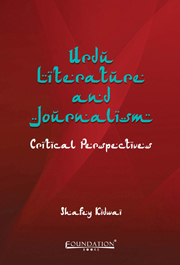Book contents
- Frontmatter
- Dedication
- Contents
- Preface
- Introduction
- Acknowledgements
- 1 Post-Independence Urdu Short Story
- 2 Post-Partition Urdu Poetry
- 3 Structuralism and Post-structuralism in Urdu Criticism
- 4 Jayant Parmar
- 5 Firaq as a Critic
- 6 Ghalib Criticism
- 7 Literature, Culture and Social Consciousness
- 8 The Influence of Tagore on Urdu Literature
- 9 Early Journalistic Endeavours of Sir Syed Ahmad Khan
- 10 Pioneering the First Urdu Book on Journalism
- 11 The Contribution of Urdu Journalists to the First War of Independence
- 12 Abul Kalam Azad's Journalistic Conquests
- Index
9 - Early Journalistic Endeavours of Sir Syed Ahmad Khan
Published online by Cambridge University Press: 05 October 2014
- Frontmatter
- Dedication
- Contents
- Preface
- Introduction
- Acknowledgements
- 1 Post-Independence Urdu Short Story
- 2 Post-Partition Urdu Poetry
- 3 Structuralism and Post-structuralism in Urdu Criticism
- 4 Jayant Parmar
- 5 Firaq as a Critic
- 6 Ghalib Criticism
- 7 Literature, Culture and Social Consciousness
- 8 The Influence of Tagore on Urdu Literature
- 9 Early Journalistic Endeavours of Sir Syed Ahmad Khan
- 10 Pioneering the First Urdu Book on Journalism
- 11 The Contribution of Urdu Journalists to the First War of Independence
- 12 Abul Kalam Azad's Journalistic Conquests
- Index
Summary
The first newspaper of India, The Bengal Gazette or Calcutta General Advertiser was launched in 1780, from Calcutta. An employee of the East India Company, James August Hickey was its founder; hence it was also known as Hickey's Gazette.
In India, Urdu and Persian journalism began almost concurrently. Raja Ram Mohan Roy launched a Persian newspaper, Miratul Akhbar from Calcutta in 1822. Tahir Masood points out that the Miratul Akhbar was not only the first Persian newspaper of India but also the first in the entire Persian speaking world, including Iran. (Masood, 2002)
A month earlier than that, the first Urdu newspaper, Jam-e-Jahan Numa was published from Calcutta. Its first issue hit the stands on 20 March, 1822. Harihar Dutt was its owner and Munshi Sukh Lal was its first editor.
About a decade later, Delhi Urdu Akhbar was launched from Delhi. The first newspaper from Delhi was launched in 1836. Sir Syed says that the Urdu Akhbar is believed to have made its appearance in 1836 in Delhi. (Krishnamurthy, 1966)
Urdu Akhbar was started by Moulvi Mohammad Baqar, a renowned scholar from Delhi. It was generally regarded as a complete newspaper that published informative and thought-provoking material on topics of public interest. Urdu Akhbar enjoyed enormous popularity.
- Type
- Chapter
- Information
- Urdu Literature and JournalismCritical Perspectives, pp. 126 - 149Publisher: Foundation BooksPrint publication year: 2014



